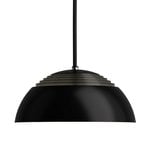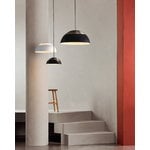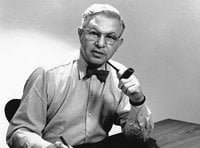The AJ Royal pendant provides ambient illumination for all kinds of spaces. The lamp’s opal diffusor ensures an even and glare-free downward light while the open rings at the top allow the light to be filtered upwards, creating a muted, smooth lighting in any room, be it above a dining table or in a restaurant, office or showroom. The lamp is also known as AJ Pendant, and it is one of the many designs created by Danish architect Arne Jacobsen for the SAS Royal Hotel in Copenhagen which opened in 1960. Jacobsen was in charge of designing the hotel in its entirety, including the decor, furniture and lighting. Since then, the AJ range has become a Danish design icon and one of the most beloved pieces created by Arne Jacobsen.


AJ Royal 250 pendant, black
Louis Poulsen
Description
The AJ Royal pendant provides ambient illumination for all kinds of spaces. The lamp’s opal diffusor ensures an even and glare-free downward light while the open rings at the top allow the light to be filtered upwards, creating a muted, smooth lighting in any room, be it above a dining table or in a restaurant, office or showroom. The lamp is also known as AJ Pendant, and it is one of the many designs created by Danish architect Arne Jacobsen for the SAS Royal Hotel in Copenhagen which opened in 1960. Jacobsen was in charge of designing the hotel in its entirety, including the decor, furniture and lighting. Since then, the AJ range has become a Danish design icon and one of the most beloved pieces created by Arne Jacobsen.
Product details (22)
- Material
- Black lacquered aluminium and steel. Built-in frosted acrylic diffusor.
- Colour
- Black
- Width
- 25 cm
- Diameter
- 25 cm
- Height
- 11.5 cm
- Light source
- EU: Integrated dimmable 8W LED / US: Integrated dimmable 9W LED
- Colour temperature
- 2,700 K
- Luminous flux
- 597 lm
- Lifetime
- 50,000 h
- IP rating
- EU: 20 / US: cULus, dry location
- Protection class
- I
- Voltage
- 220–240 V
- Nominal frequency
- 50–60 Hz
- Certifications and labels
- EU: CE marked, tested and approved according to European standards
- Cable length
- 300 cm
- Cable colour
- Black
- Cable material
- Textile
- Weight
- 2.4 kg
- Canopy
- Yes (black)
- Ceiling plug
- No
- Dimmable
- Yes: phase dimming
- Notes
- Can be dimmed with phase dimming using standard dimmers with either leading edge or trailing edge technology.
- Product ID
Designer
Arne Jacobsen (1902-1971) is the most celebrated post-war Danish designer and architect. He graduated from the School of Applied Arts in 1924 and from the Royal Danish Academy of Fine Arts, where he studied architecture, in 1927. Arne Jacobsen worked actively both as an architect and as a designer and received many prestigious awards for his designs, including C. F. Hansen Medal and the Grand Prix of Milan XI Triennale.
Jacobsen’s most famous project was the Royal Hotel in Copenhagen (1956-1960), for which he designed every detail from textiles and lamps to cutlery and furniture. The AJ lamps, designed for the Royal Hotel and manufactured by Louis Poulsen, are a fine example of his streamlined and elegant style. The cutlery designed for the Royal Hotel and produced by Georg Jensen, represents a stylish design that is still today much praised. Also, the famous Egg and Swan chairs were designed for the Royal Hotel. As often happened with Arne Jacobsen’s designs, they were initially realized for a certain project and only later put into serial production – the same happened for the AJ lamps, the cutlery and the furniture he designed for the hotel. Royal Hotel was an extremely important project for Jacobsen because he could finally put his theories of integrated design and architecture into practice.
Jacobsen is well-known also for the Cylinda Line range, designed for Stelton in 1967. Since the very beginning, Cylinda Line has been an undisputed icon of Scandinavian design and today the range is part of numerous permanent collections in design museums all over the world.
• Read our article on Arne Jacobsen >
View all productsReviews (0)
Sustainability
The Product Sustainability Framework, our criteria of sustainable design, helps you find the most sustainable products in our selection. Read below which sustainability criteria this product has met.
Working conditions & labour 7/9
-
Equal opportunities for all employees
-
Commitment to UN Global Compact, fair compensation for all employees
-
Corporate responsibility requirements defined and communicated for suppliers
-
Systematic work for improved inclusion and well-being in the workplace
-
Transparent supply chain
-
Suppliers' compliance to a code of conduct ensured
-
Compliance to the UN Guiding Principles on Business and Human Rights ensured in the supply chain
-
Direct suppliers audited and certified
-
Support for community involvement in the supply chain
Eco-friendly production 7/9
-
Fair and resource-wise water-use in production
-
No incineration or landfilling of returned items
-
No use of endangered species as materials
-
No direct environmental emissions or waste (excl. GHGs) from production
-
The sustainability of direct suppliers' production is addressed and monitored
-
Material-efficient and ecological packaging
-
No potentially harmful chemicals used in own production
-
Production and material sourcing that respect biodiversity, animal rights, and natural ecosystems
-
Positive impact on nature’s well-being through operations that regenerate natural ecosystems
Climate impact 6/8
-
Company's direct greenhouse gas emissions identified and commitment to reduction
-
Product's carbon impact identified and commitment to reduction
-
Guidance on energy- and eco-efficient use of the product
-
Contribution to climate initiatives beyond the brand’s direct operations
-
Carbon footprint of the product calculated and goals set to reduce it
-
Carbon neutral or carbon negative product
-
Low-carbon or compensated transportation
-
100 % renewable energy in own production and operations
Sustainable materials 5/6
-
Sustainable and long-lasting material choices
-
No harmful or hazardous substances
-
Responsible raw material sourcing and production
-
Materials suited for circularity: monomaterials, recyclable finishings, renewable or recycled contents etc.
-
Ecological materials: natural, biodegradable, recyclable or recycled contents
-
Outstanding materials in terms of innovativeness, responsibility, sustainability and circularity: local production or sourcing, 100 % recycled content, C2C-certification etc.
Circular design 4/5
-
High aesthetic quality promoting long-term use of the product
-
Technically durable product design and material choices
-
Design for enduring life-long quality
-
Design and support for product maintenance, repair and upgradability
-
Innovative circular design solutions: circular service system, resale platform, remanufacturing, collection of used products, etc.





